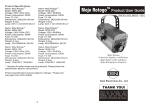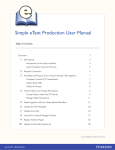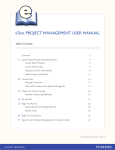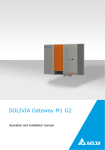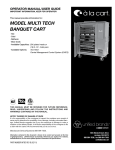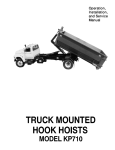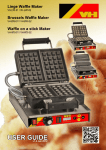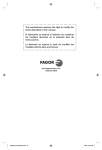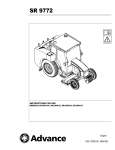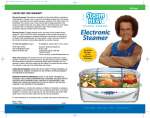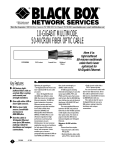Download 9 A world of machines
Transcript
9 A world of machines ONLINE PAGE PROOFS Engineers use scientific knowledge to design and build machines that make life easier, bridges that carry heavy loads, and buildings that don’t fall over. Machines transfer energy to or from an object by the action of a force. We all use machines every day to make life easier, sometimes without even noticing. The human body could not move without the many simple machines inside. Think about machines • How does a bathroom tap make life easier? • Where can you find machines inside the human body? • Who’s the boss — you or your car? • How could you lift many times your own weight by yourself? • How did Archimedes try to prove that he could single-handedly move the whole Earth? • Why do bicycles have gears? • Why do roads wind around mountains instead of going straight up? In this chapter: 9.1A helping hand 278 9.2Pushing uphill 283 9.3Systems: Wheels and axles in a spin 285 9.4Getting into gear 289 9.5 SCIENCE AS A HUM A N E N D E AV O U R Compound machines 291 9.6Thinking tools: Single bubble maps and Venn diagrams ONLINE ONLY Study checklist/Digital resources 295 Looking back 296 ICT activity Paper, Scissors, Robot 297 ONLINE PAGE PROOFS YOUR QUEST INVESTIGATION 9.2 Exploring simple machines A machine is a device that makes a physical task easier. That means that cars, bikes, cranes, lifts and escalators are machines. But machines like these are actually made up of many smaller machines called simple machines. Simple machines transfer energy from one object to another to make it move or change direction. Hard as nails AIM To investigate the use of a lever to remove a nail from wood METHOD and results ◗◗ ◗◗ INVESTIGATION 9.1 As simple as a spoon DISCUSS AND EXPLAIN AIM To explore how a lever can make a task easier 1 2 METHOD and results ◗◗ 3 ◗◗ ◗◗ ◗◗ Hammer DISCUSS AND EXPLAIN 1 2 Spoon Lid Can Nail Wood 9 A world of machines 277 9.1 A helping hand ONLINE PAGE PROOFS Can-openers, scissors, tongs, spanners, hammers, brooms, tennis racquets and staplers are levers. A lever is a simple machine that uses the turning effect of a force. The turning point of a lever is called its fulcrum. The resistance to motion that a lever works against is called the load. The force used to cause movement is called the effort. The wheelbarrow and nutcracker shown below are also force-multiplying levers. However, the load is between the fulcrum and the effort. Such levers are called second-class levers. A door (not a sliding one!) is another example of a second-class lever. WHAT DOES IT MEAN? The lever shown in the illustration below is a first‑class lever. The fulcrum lies between the effort and the load. A seesaw is another example of a first-class lever. Firstclass levers are force multipliers because they ‘multiply’ your effort. Effort What’s the advantage? The advantage of force-multiplying levers is that they allow you to move a heavy load with a small effort. Effort Fulcrum Load Load Spoon being used as a first-class lever Fulcurm Load Effort The wheelbarrow and nutcracker are examples of second-class levers. They allow you to move large loads that you would not be able to move without help. 278 Science Quest 7 ONLINE PAGE PROOFS The mechanical advantage of a force-multiplying lever is defined as: mechanical advantage = load/effort. For example, when you use the lever below to raise a load of 6 coins with an effort of only 3 coins, the mechanical advantage is given by: mechanical advantage = load /effort = 6 ÷ 3 = 2. In other words, the lever lifts a load that is two times greater than the effort. The mechanical advantage of this lever is 2. A softball bat is a third-class lever designed to move a small load quickly. Load (6 coins) Effort (3 coins) Ruler Pencil Surface Levers with the effort between the fulcrum and the load are called third-class levers. Third-class levers are not force multipliers. They move a load through a larger distance than the effort moves in the same time and are therefore speed multipliers. The softball bat shown above right is a third-class lever. Golf clubs, tennis racquets and brooms are also third-class levers designed to move a small load quickly with a large effort. HOW ABOUT THAT! INVESTIGATION 9.3 Pushing your barrow AIM To investigate how a wheelbarrow makes lifting a load easier METHOD AND RESULTS ◗◗ ◗◗ ◗◗ 1 2 9 A world of machines 279 INVESTIGATION 9.4 ◗◗ Get a load of this AIM To investigate the relationship between effort and its distance from the fulcrum DISCUSS AND EXPLAIN 5 6 ONLINE PAGE PROOFS 7 METHOD AND RESULTS 1 ◗◗ Number of weights Distance from fulcrum (cm) Effort Number of weights Distance from fulcrum (cm) 2 ◗◗ 3 ◗◗ 4 A word about energy Although levers can ‘multiply’ a force or speed, the Law of Conservation of Energy is never broken. The Law of Conservation of Energy states that energy cannot be created or destroyed. It can only be transferred to another object or transformed into a different form. You can never get more energy out of a lever than you put in. Your elbow is the fulcrum. It is the turning point of the lever. The load is the weight that you are trying to lift upwards. The effort is between the fulcrum and the load, so your forearm is acting as a third-class lever and a speed multiplier. When you bend your arm to lift a load, your forearm acts as a third-class lever. Body levers Many of the bones in your own body are levers. The long bones in your arms and legs are the most obvious examples of levers. Joints such as your elbow and knee act as fulcrums. Your muscles pull on part of the bone to provide the effort. The load is the resistance to motion that your bone works against. The load could be the weight of a basketball, a soccer ball, a bucket of water or a heavy weight in the gym. Levers in your arm When you bend your arm to lift a weight, the effort is provided by your biceps muscle where it joins a bone called the radius in your forearm, just below the elbow. 280 Load ◗◗ Science Quest 7 Biceps contracts and pulls. Triceps relaxes. ONLINE PAGE PROOFS Triceps contracts and pulls. When you straighten your arm to push downwards, such as when you do push-ups or push a weight down, your forearm acts as a first-class lever and force multiplier. The fulcrum is your elbow. The effort is provided by your triceps muscle, which is joined to a Biceps bone in your forearm relaxes. called the ulna. The load is the resistance to your downward push. In this case, the fulcrum is between the effort and the load. When you straighten your arm to push downwards, your forearm acts as a first-class lever. Kicking a ball When a football is kicked, bones in the lower leg act as a third-class lever. The knee is the fulcrum. The effort needed to straighten the leg is provided by muscles attached to the top of the lower leg. Fulcrum The lower part of the footballer’s leg pivots around the knee. The knee is the fulcrum in this lever. Load The load moves a long distance. The load is the resistance to motion of the football. Although there is little movement where the effort is applied, the foot (where the load is) moves a large distance. Anyone for tennis? In ball games such as tennis, cricket, baseball, golf and hockey, racquets, bats, clubs and sticks are used as third-class levers. The end of the lever that strikes the load (the ball) moves much faster than the end of the lever where the effort is applied. When a tennis ball is served, the lever consists of your whole arm and the tennis racquet. The fulcrum is your shoulder, the effort is applied by the muscles attached to the bones of your upper arm, When a tennis ball is served, the arm and the load and tennis racquet is at the centre work together of the racquet. as a third-class lever and speed The larger the multiplier. distance between the load and the effort, the faster the serve. Professional tennis players can serve tennis balls at speeds of up to 240 km/h. This is many times the speed of the upper arm where the effort is applied. Why warm up? Effort Most of the effort needed to straighten your leg when kicking a ball comes from the muscles in your legs. The effort to kick a ball is applied by muscles that attach to the top of your lower leg. The muscles that pull on your bones to make them move are made up of tough and elastic fibres. When they are cold, the muscles are less elastic. If you overload muscles without warming up they can easily tear. Even with warming up, if muscles have not been prepared for sport by proper training, they can easily be torn when sudden movements are made. 9 A world of machines 281 UNDERSTANDING AND INQUIRING 9 REMEMBER 10 1 2 Tongs ONLINE PAGE PROOFS Shovel Tongs Shovel 3 Tongs Shovel Door Plank Door Plank 4 Door Plank 5 6 THINK 11 12 7 8 13 In cricket, the bowling arm is used as a lever. CREATE 14 INVESTIGATE 15 16 17 work sheet 282 Science Quest 7 9.1 Loaded levers ONLINE PAGE PROOFS 9.2 Pushing uphill Imagine how difficult it must have been for the ancient Egyptians to build the pyramids at Giza. The Great Pyramid was built from over 200 million blocks of limestone, most with masses over 2 tonnes. It is believed that the blocks were dragged from nearby quarries by gangs of men. The task of lifting the blocks to heights of over 140 metres was made possible by building long ramps of brick and sand. As each layer of limestone blocks was completed, the ramps were extended so that the next layer could be commenced. WHAT DOES IT MEAN? Inclined planes A ramp is a machine because it makes the physical task of raising an object easier. A ramp is simply an inclined plane — a surface that is set at an angle to the horizontal. It allows objects to be raised with less effort than would be needed to lift them straight up. Ramps are used in shopping centres and other buildings to allow wheelchairs, prams and strollers to be raised with less effort. Although a smaller effort is needed when using a ramp, the load must be moved through a larger distance. Escalators are moving ramps. The winding mountain road in the photograph on the next page is also a ramp. Imagine how much shorter the trip would be if the road went straight up the mountain — but no vehicle would be powerful enough to use the road. When an object is pushed up an inclined plane, energy is transformed from the energy of movement (kinetic energy) into stored energy (potential energy). If an object at the top of an inclined plane is allowed to slide or roll down, some of its potential energy is transformed back into kinetic energy. Inclined planes at work Wedges are inclined planes. They can be used to penetrate or split objects, or to stop them from moving. Axes, knives and your front teeth are examples of wedges. They reduce the force needed to cut through objects. If you have ever tried to cut through a hard INVESTIGATION 9.5 Inclined to make it easier ◗◗ AIM To investigate how an inclined plane makes a task easier 3 DISCUSS AND EXPLAIN METHOD AND RESULTS 4 ◗◗ 5 ◗◗ 6 1 7 2 9 A world of machines 283 ONLINE PAGE PROOFS piece of food like an apple with a blunt knife, you will know the value of a wedge. Screws are inclined planes. A screw is a curved ramp. However, instead of an object being pushed up the ramp, the ramp is pushed down into the object. The ramp cut into a screw is called the thread; the distance between two turns of the thread is called the pitch. Because the total length of the thread is so great, its force-multiplying effect is very large. Most car jacks use a large screw to lift a huge load with little effort. Similarly, a corkscrew is used to penetrate the tightly fitted cork of a wine bottle with little effort. The cork is then removed by pulling the corkscrew out directly. INVESTIGATION 9.6 Wedge Inclined planes on the move AIM To investigate how a wedge makes a task easier Handle METHOD AND RESULTS ◗◗ Rubber bands ◗◗ Shaft ◗◗ Blade 1 DISCUSS AND EXPLAIN 2 UNDERSTANDING AND INQUIRING REMEMBER 1 2 3 4 284 This winding mountain road is a ramp. Science Quest 7 THINK 5 6 7 8 Screw ONLINE PAGE PROOFS 9.3 Systems: Wheels and axles in a spin A circular doorknob is a simple machine called a wheel and axle. It is actually a lever that can rotate. The inner, smaller wheel of the doorknob is the axle. When you open a door you apply an effort to the wheel and the axle pulls on the load to open the door. The fulcrum, or turning point, is at the very centre of the doorknob. This doorknob is a wheel and axle machine. The handle is the wheel, which turns in a circle. The spindle inside is the axle, and it turns in a smaller circle. The doorknob in the photo is a force multiplier. You apply a small effort to the wheel to move a large load with the axle. There is, however, a penalty; you pay for the extra force with extra distance. The wheel (handle) moves further than the axle. Imagine, however, how difficult it would be to turn the axle without a handle. Bathroom taps and car steering wheels are also force-multiplying wheels and axles. Can you think of any others? INVESTIGATION 9.7 Getting a handle on wheels and axles AIM To investigate how wheels and axles make a task easier Handle METHOD AND RESULTS ◗◗ Shaft ◗◗ ◗◗ Screw A screwdriver is a wheel and axle. 1 DISCUSS AND EXPLAIN Speed it up 2 Wheel and axle machines can be used to make things move faster. The ceiling fan in the photograph below is a wheel and axle machine. A large force is applied to the axle. Each time the axle turns, the fan blades move a much greater distance in the same amount of time. It is a speed multiplier. The ceiling fan transfers kinetic energy, from the motor that makes the axle turn, to the fan blades. A car wheel is another example of a speed multiplier. The axle 3 This ceiling fan is a speed-multiplying wheel and axle machine. The fan blades trace out a complete circle. Electricity is used to make the axle turn, and the fan blades move faster than the axle. Blade turns when a large force is applied to it. The outside of the wheel moves faster, covering a much greater distance in the same time. Pairs of wheels and axles are sometimes joined together with a chain or belt. This either reduces the effort needed to make one of the wheels turn or makes one of the wheels turn faster. The fanbelt in a car is one example. Wheels and axles joined by belts are also used to operate heavy machinery in factories. 9 A world of machines 285 ONLINE PAGE PROOFS 286 These wheels and axles are joined by a belt to operate heavy machinery. A single pulley simply changes the direction of the effort needed to lift a load. INVESTIGATION 9.8 Wheels and axles at work AIM To investigate how wheels and axles can become force or speed multipliers METHOD AND RESULTS ◗◗ ◗◗ 1 2 Getting a lift A pulley is a special type of wheel and axle that makes it easier for you to lift a load. The wheel has a groove around it so that a rope or cable can be passed over or under it. A pulley does not decrease the size of the force, or effort, needed to lift the load. It changes the direction of the effort. It is easier to pull down on a rope to lift a load than it is to push the load. Your own weight can be used to advantage. When more than one pulley is used, a large load can be lifted with a small effort. A system of two or more pulleys therefore acts as a force multiplier. It magnifies the size of the effort. As with other force multipliers, there is a cost. The rope needs to be pulled through a large distance to move the load through a small distance. Science Quest 7 A multiple-pulley system is usually called a block and tackle. The block is the frame around the pulleys. The tackle is the string or cable joining the load to the effort. With a block and tackle it is possible to lift many times your own weight. Of course, you have to pay for it by pulling over a long distance. The woman in the photo above is using the pulley to transfer energy from herself to the weight to make it move. In order to move the load, her muscles need to transform the chemical energy that she has stored by eating food into movement energy of her arms. A block and tackle system is used in garages to lift engines out of cars. It is also used on cranes, wharves and ships. A block and tackle is used to lift or pull heavy loads. HOW ABOUT THAT! ONLINE PAGE PROOFS INVESTIGATION 9.9 4 Lifting that load ◗◗ AIM To compare the mechanical advantage of three pulley arrangements DISCUSS AND EXPLAIN 5 (b) (a) (c) METHOD AND RESULTs 1 Effort ◗◗ Effort Effort Load Load ◗◗ Load The pulley systems to be tested in the experiment: (a) single pulley (b) two single pulleys (c) two double pulleys 2 ◗◗ 6 ◗◗ 7 3 8 9 ◗◗ 10 ◗◗ ◗◗ Lifting a load with pulleys Pulley arrangement Load (N) Load distance (cm) Single pulley 5.0 Two single pulleys 5.0 Two double pulleys 5.0 Effort (N) Effort distance Mechanical advantage (cm) (load/effort) 9 A world of machines 287 UNDERSTANDING AND INQUIRING 11 REMEMBER 1 2 3 ONLINE PAGE PROOFS System R System P 4 Effort 5 Effort 6 THINK Load 7 Load System Q Effort A car steering wheel is a wheel and axle machine. Load CREATE 12 INVESTIGATE 13 8 14 9 10 288 Science Quest 7 work sheet 9.2 Measuring forces ONLINE PAGE PROOFS 9.4 Getting into gear Most people associate gears with cars or bikes, but you can also find gears in the kitchen. The gears in this clock allow its three hands to move around its face at different speeds. A hand-operated eggbeater has gears that are used to change both the direction and speed of motion. Each of the gears in a clock is simply a wheel and axle with teeth. The teeth of one gear fit between the teeth of another gear. When one gear turns, the other can be made to turn faster, slower or in a different direction. The gears in the clock allow the three hands to move around the face of the clock at different speeds. The wheel that is moved first is called the driving gear. Usually the driving gear is moved by a person or a motor. On a bicycle, it is moved by pedalling, while in the eggbeater shown at left the driving wheel is moved by the handle. The wheel that is moved by the driving gear is called the driven gear. In a handoperated eggbeater there are two driven gears. Driving gear Driven gear Driven gear Driving gear INVESTIGATION 9.10 Looking at gears AIM To investigate how a machine with gears makes a task easier METHOD AND RESULTS ◗◗ ◗◗ 1 2 DISCUSS AND EXPLAIN 3 4 5 6 7 9 A world of machines 289 ONLINE PAGE PROOFS Big wheels, small wheels Different sizes and arrangements of gears are used to make wheels turn faster, slower or in different directions. A large driving gear makes a small driven gear move faster, but in the opposite direction. Handoperated eggbeaters and drills use this combination of gears to make them spin quickly. A small driving gear makes a large driven gear move slower but in the opposite direction. This arrangement acts as a force multiplier. It is used to move Bevel gear large loads with a small effort. This arrangement is used in cars to allow them to climb hills or gather speed quickly. It is also used in rotating shopwindow displays to make them turn slowly. Pairs of gears the same size change the direction of turning without changing the speed. Gear wheels at right angles to each other can change vertical motion into horizontal motion. Hand-operated eggbeaters and drills use this arrangement. An idler gear can be used between the driving and driven gears to make them Idler gear turn in the same Driven direction. Why gear do you think that it is called an idler gear? Driving gear Rack and pinion gears consist of a flat row Circular of teeth, called a gear wheel rack, and a circular gear Rack wheel. A corkscrew uses rack and pinion gears to change the circular movement of the driving gears into the upward, straight-line movement that pulls the cork out. This corkscrew uses rack and pinion gears. UNDERSTANDING AND INQUIRING REMEMBER 1 7 2 3 4 8 CREATE 9 THINK 5 6 work sheet 290 Science Quest 7 9.3 Which way? ONLINE PAGE PROOFS 9.5 SCIENCE AS A HUMAN ENDEAVOUR Compound machines A bicycle is a compound machine made up of many simple machines. The obvious ones are the front and rear wheels, handbrake and pedals. But if you look carefully you can find many others. All compound machines are made up of two or more simple machines, including levers, wheels and axles, pulleys and gears. On your bike Front and rear wheels Each of the front and rear wheels is an example of a wheel and axle. The rear wheel is made to turn by another wheel and axle — the pedals. The axle of the pedals is joined to the axle of the rear wheel by a chain. The rear wheel and axle is a speed multiplier. The rear wheel axle is much smaller than the back wheel. When it turns, the back wheel turns very quickly. The front wheel is pushed along the road by the rest of the bicycle. most suitable when riding quickly on a level road. When riding up a steep slope, speed is less important. If the smaller front sprocket is used with the largest rear sprocket, you can climb the slope with less effort. You do, however, need to make more turns of the pedals. Handbrake The handbrake is an example of a first-class lever. The fulcrum is between the effort and the load. When the rider squeezes the handle of the handbrake, the effort is transferred along a cable to the brake pads that push against the wheel. Handbrake Sprockets On four wheels The car is also a compound machine. But it is made up of many more simple machines than the bicycle. Most of the simple machines in a car are under the bonnet, but the most obvious ones are the wheels and axles that roll along the road, and the steering wheel. Gears HOW ABOUT THAT! The gears on a bicycle usually act as speed multipliers. Bicycle gear wheels are called sprockets. Although the front and rear sprockets are connected by a chain, they work just like gears with teeth that fit together. The front sprockets are larger and have more teeth than the rear sprockets. The highest wheel speed can be reached with the least effort when the larger front sprocket is used with the smallest rear sprocket. This combination is 9 A world of machines 291 ONLINE PAGE PROOFS The front wheel and axle of this vehicle act as a speed multiplier. A very large force moves the axle in a small circle. The outside edge of the wheel turns in a large circle, and much faster than the axle. 292 transferring the energy of the gas particles to drive a motor, which turned the wheels. The steam was obtained by burning coal or wood to boil water. Steam engines were much more suitable for fuelling trains than cars because they could carry large amounts of coal or wood on board. Even though steam-fuelled trains have been largely replaced by diesel or electric trains, there are still many in service throughout the world. Fuelling compound machines Machines don’t create energy. They reduce the effort you need to apply, or they reduce the distance over which you need to apply a force. The Law of Conservation of Energy applies to all machines. The total energy you can get out of a machine is equal to the amount of energy that you (or a fuel) puts in. However, the total amount of useful energy you get out of a machine is always less than the amount that goes into it. That’s because some energy is always lost to the machine or the surroundings as heat. Many simple machines and some compound machines, including bicycles, scooters and skateboards, are fuelled by the energy a person provides. Most motor vehicles are fuelled by petrol, gas, diesel or ethanol. Before 1920, many cars were fuelled by steam, Many of the earliest cars were fuelled by steam. Science Quest 7 Steam-fuelled trains are still in use throughout the world, often as popular tourist attractions. Well-oiled machines Friction is an enemy of compound machines and some simple machines, such as wheels and axles, gears and pulleys. When moving parts rub against each other, they heat up and cannot move quickly. To avoid problems caused by friction, the moving parts of machines need to be: • kept free from dirt and dust • lubricated with grease or oil. As mechanical systems, machines are designed to transfer energy by the action of a force. Energy transferred within a machine as heat is energy wasted. Compound machines are designed by mechanical engineers and kept safe and in working order by mechanics. The challenge for engineers is to design machines that are safe, energy efficient and suitable for the conditions in which they are used. Mechanics are to compound machines what medical practitioners are to people. They are problem solvers — keeping the machines they work on in good working order and finding ways to fix problems and, in some cases, detecting problems that have not been noticed before. ONLINE PAGE PROOFS Untouched by human hands Robots are compound machines that perform physical tasks without direct human assistance. They can be used to do jobs that are unpleasant, dangerous or boring. Robots can work in hot weather, cold weather, under water, under the ground, in outer space and in noisy places. They don’t spread germs and they don’t get tired. Most robots are controlled by computers. Some are guided by remote-control units — similar to those used to operate DVD players and TV sets. Some robots can ‘see’ and ‘hear’ using video cameras and microphones. What happens when the robot is brought into a new space to clean? It uses an infra-red beam to measure the approximate distance across a room. The computer then calculates approximately how long it should take for the robot vacuum to clean that room. It starts vacuuming at the centre of the room and spirals out until it reaches the perimeter or an obstacle. When either of these things happens, the robot avoids bumping into the walls or obstacle using a short-range infra-red sensor. Another infra-red sensor is directed at the area in front of the robot. Usually the return signal occurs very quickly from the ground, which is not very far away. However, if stairs or a ‘void’ are encountered, the return signal takes longer (this is called the ‘cliff’ effect); this is detected by the robot and it turns around or backs up to avoid disaster. Most robots are used to perform simple tasks that humans would find unpleasant, boring or dangerous. These robots are used to put the parts of a car body together. Robot vacuum cleaners No time to clean the house? Maybe a robotic vacuum cleaner can do the work for you. These robotic vacuums are really compound machines that contain a variety of sensors, motors and computer circuits. They are able to sense how large a room is, whether there is something blocking their path and how long it will take to get the vacuuming done. They even find their way back to a charging station when they are low on battery capacity. Most robot vacuums have five motors in total and are driven by two wheels controlled by two motors. The robot can turn depending on how fast each wheel turns. A third wheel can freely rotate and balances the robot. The other three motors control the vacuum suction, the side sweeping brush and an agitating brush. WHAT DOES IT MEAN? 9 A world of machines 293 UNDERSTANDING AND INQUIRING REMEMBER 1 18 2 3 ONLINE PAGE PROOFS 4 5 IMAGINE 19 6 7 THINK 8 9 10 BRAINSTORM 20 11 12 13 14 INVESTIGATE The car — servant or master? 15 Advantages of cars 16 17 21 22 294 Science Quest 7 Disadvantages of cars ONLINE PAGE PROOFS STUDY CHECKLIST SIMPLE MACHINES ■■ explain how a mechanical advantage can be obtained from simple machines such as levers, inclined planes, pulley systems and gears ■■ explain how friction can be reduced in machines to reduce energy losses SCIENCE AS A HUMAN ENDEAVOUR ■■ distinguish between speed- (or distance-) multiplying machines and force-multiplying machines ■■ explain how inclined planes made tasks easier in an ancient civilisation ■■ describe the effects of forces that can cause objects to change the motion of an object ■■ identify that mechanics and mechanical engineers need to know how simple and compound machines work to apply forces ■■ recall that you cannot get any more energy out of a machine than you put in ■■ describe the action of levers in the human body ■■ explain how sports scientists can use their knowledge of levers in the human body to improve the performance of athletes ■■ consider and discuss the advantages and disadvantages of a dependence on cars for transport COMPOUND MACHINES ■■ distinguish between compound machines and simple machines ■■ identify how simple machines work together in compound machines such as bicycles, lifts, cranes and hydraulic brakes ■■ identify some of the benefits of robots to humans Digital resources Answers for this chapter can be found online in your eBookPLUS. Interactivities Spanner Learn how a spanner multiplies force. Online section This section of the chapter can be found online in your eBookPLUS. 9.6Thinking tools: Single bubble maps and Venn diagrams ONLINE ONLY Searchlight ID: int-0023 Gears Learn how gears are used to make a wheel turn faster. Individual Pathways Activity 9.1 Investigating mechanical systems Activity 9.2 Analysing mechanical systems Activity 9.3 Investigating mechanical systems further doc-6060 doc-6061 doc-6062 Searchlight ID: int-0025 Gear ratios An investigation looking at the effect of different-sized gears. FOCUS activity Access more details about focus activities for this chapter in your eBookPLUS. doc-XXXX Searchlight ID: int-0746 9 A world of machines 295 LOOKING BACK 1 Copy the following diagrams and label the fulcrum, load and effort on each of the levers. The first diagram is labelled for you. (a) Load (b) Effort (c) ONLINE PAGE PROOFS Load Fulcrum Effort (e) (d) 2 A student uses a pencil and ruler to model a first-class lever. It is tested by lifting 20-cent coins placed at one end of the ruler. (a) Draw a diagram to show how a pencil and ruler can be set up to model a first-class lever. Label the fulcrum, effort and load. (b) Calculate the mechanical advantage of the lever when it uses four coins to lift 12 coins. (c) If the 12 coins are placed six centimetres from the fulcrum, how far should the four coins be from the fulcrum to lift the larger pile of coins? 3 A flight of stairs is an example of a simple machine. (a) Which simple machine is a flight of stairs most similar to? (b) Are stairs force multipliers or speed multipliers? Explain your answer. 4 Which of the following is a speed multiplier and which is a force multiplier? Driving gear Driven gear Driven gear Driving gear 5The plank below is 3.6 metres long. It is being used as a lever to lift a 40-kilogram box. This represents a load of 400 newtons. Link to assessON for questions to test your readiness FOR learning, your progress AS you learn and your levels OF achievement. www.assesson.com.au (a) If the fulcrum were placed in the centre of the plank, what downward effort would the man on the right of the diagram need to apply to raise the box? (b) If the man wants to push down on the end of the plank with an effort of only 200 newtons: (i)how far along the plank should the fulcrum be (ii)what would the mechanical advantage of the lever be? (c) How could the mechanical advantage of the lever be increased? (d) Is the plank being used as a speed multiplier or a force multiplier? Explain your answer. (e) Suggest a different way of using the plank as a simple machine to get the box into the truck. 6 Imagine that you wanted to drive a screw into a length of wood. If you had a choice of using one of the screwdrivers illustrated on the right, which one would you use? State a reason for your choice. 7 A softball bat is an example of a speed‑multiplying lever. (a) Explain why the softball bat is not a force-multiplying lever. (b) Where is the fulcrum of the softball bat? (c) Which class (first, second or third) of lever is the softball bat? (d) Which other lever is used to help the softball on its way at high speed? 8 The bicycle shown below is made up of many simple machines. Identify as many as you can. Classify the simple machines that you identify as levers, inclined planes, wheels and axles, pulleys and gears. If you look thoroughly, you might be surprised at how many you find. 9 Create a poster or a series of PowerPoint slides to explain how one of the following machines works. Ensure that you indicate whether the machine is a speed multiplier or a force multiplier. (a) Water tap (b) Eggbeater (c) Corkscrew (d) Bicycle gears work sheet 296 Science Quest 7 9.4 T hinking tools: Single bubble maps and Venn diagrams 9.5 Summing up 9.6 Looking back crossword ONLINE PAGE PROOFS ICT Activity Process Paper, Scissors, Robot SEARCHLIGHT ID: PRO-0089 Scenario Robots are highly advanced electrical machines that can be programmed to perform specific tasks. Like all compound machines, they are made up of many smaller interacting devices that are referred to by engineers as simple machines. In general, there are considered to be seven types of simple machine — lever, screw, inclined plane, gear, pulley, wheel and axle, and wedge. Our bodies are able to move around because the muscles, bones, tendons and ligaments also act like simple machines. For example, an incisor is really an organic form of a wedge, while the movement of your forearm is possible because it is a lever, with your elbow acting as the fulcrum. The robotic hands that prosthetic engineers design are the result of combining processed materials such as metal alloys and polymers to create systems of simple machines that imitate the motion of a real hand as closely as possible. Open the ProjectsPLUS application for this chapter located in your eBookPLUS. Watch the introductory video lesson and then click the ‘Start Project’ button to set up your project group. You can complete this project individually or invite other members of your class to form a group. Save your settings and the project will be launched. Your task • You are going to design and build a robot hand that is capable of performing all of the hand motions used in the game of Paper, Scissors, Rock. You will then use your robot hand to compete with those created by other student groups in your class to find the Paper, Scissors, Robot champions. This tournament will be done as a round-robin competition, with each group playing every other group once. Your robot hand must be sturdy enough to keep functioning throughout the tournament. • You will also create a user’s manual that goes with your robot hand. This will provide a detailed diagram/ plan of your robot hand, including an explanation of how it is constructed and how the user makes it move into the three different positions required. In the back of the manual there should also be a ‘Troubleshooter’ table that will tell the user what the most common problems are that they may experience when using the hand and provide solutions to fix those problems. 9 A world of machines 297






















